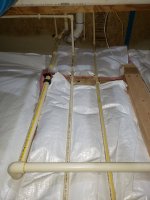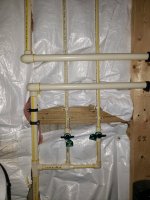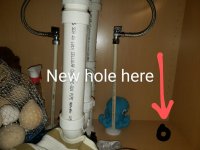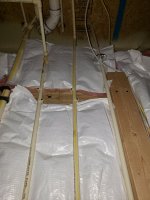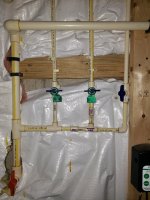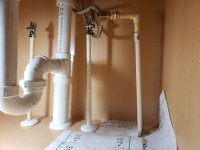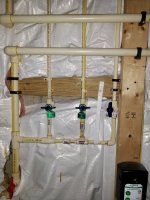AC_in_DC
New Member
Hello folks,
I am new here. I found this site while searching the internets for help with my DIY project. I have searched the forums for answers, so please pardon if this subject has already been visited.
The problem: We have a salt-based water softening system at home. Unfortunately, none of us likes the taste of the softened water so we have an RO system under the sink for drinking water. The plants don’t do well with the softened water and the dog would rather not drink it (fussy b@$t@rd!). This is primarily a winter problem because we have the outside faucets shut off. In other seasons, we can easily get water from the outside faucets.
Current solution: Wife makes me go to the basement with the watering can to fill it for her. It is tiring. She can’t do it cos the only way to get untreated water is from the spin-off sediment filter and the force of the water is too much for her to handle and the can gets pretty heavy.
New solution and DIY project: Install a faucet at the sink for the untreated water. This faucet will be used only for filling the watering can and the dog’s water bowl. (I considered somehow installing a garden faucet that has threads to connect hoses to but I think that will look ugly and there is the risk of the hose leaking and what not.)
I found this at HD (after searching for hours!).
https://www.homedepot.com/p/Glacier-Bay-Single-Hole-Single-Handle-Low-Arc-Bathroom-Faucet-in-Chrome-6011-5001/206495208
Wish I could find one in a brown or black color (visual indication that this water is different) but so far no luck.
Now this faucet has a ½ inch connector. My research so far recommends a 1 3/8 hole size to be drilled into the countertop. I have drilled a ½ inch hole in the countertop before to install the RO system faucet. So here is the question:
TLDR
1. Should I drill a 1 3/8 inch hole in the countertop for a ½ inch connection size faucet?
2. Will drilling a hole the same size as the pipe on the faucet cause any problems due to expansion/contraction of the pipe?
3. Is this faucet too small for the intended purpose? (Have to read a little to understand this question – sorry!)
Thank you!
AC_in_DC
(some pictures of what my project entails.)
I am new here. I found this site while searching the internets for help with my DIY project. I have searched the forums for answers, so please pardon if this subject has already been visited.
The problem: We have a salt-based water softening system at home. Unfortunately, none of us likes the taste of the softened water so we have an RO system under the sink for drinking water. The plants don’t do well with the softened water and the dog would rather not drink it (fussy b@$t@rd!). This is primarily a winter problem because we have the outside faucets shut off. In other seasons, we can easily get water from the outside faucets.
Current solution: Wife makes me go to the basement with the watering can to fill it for her. It is tiring. She can’t do it cos the only way to get untreated water is from the spin-off sediment filter and the force of the water is too much for her to handle and the can gets pretty heavy.
New solution and DIY project: Install a faucet at the sink for the untreated water. This faucet will be used only for filling the watering can and the dog’s water bowl. (I considered somehow installing a garden faucet that has threads to connect hoses to but I think that will look ugly and there is the risk of the hose leaking and what not.)
I found this at HD (after searching for hours!).
https://www.homedepot.com/p/Glacier-Bay-Single-Hole-Single-Handle-Low-Arc-Bathroom-Faucet-in-Chrome-6011-5001/206495208
Wish I could find one in a brown or black color (visual indication that this water is different) but so far no luck.
Now this faucet has a ½ inch connector. My research so far recommends a 1 3/8 hole size to be drilled into the countertop. I have drilled a ½ inch hole in the countertop before to install the RO system faucet. So here is the question:
TLDR
1. Should I drill a 1 3/8 inch hole in the countertop for a ½ inch connection size faucet?
2. Will drilling a hole the same size as the pipe on the faucet cause any problems due to expansion/contraction of the pipe?
3. Is this faucet too small for the intended purpose? (Have to read a little to understand this question – sorry!)
Thank you!
AC_in_DC
(some pictures of what my project entails.)
Attachments
Last edited:

